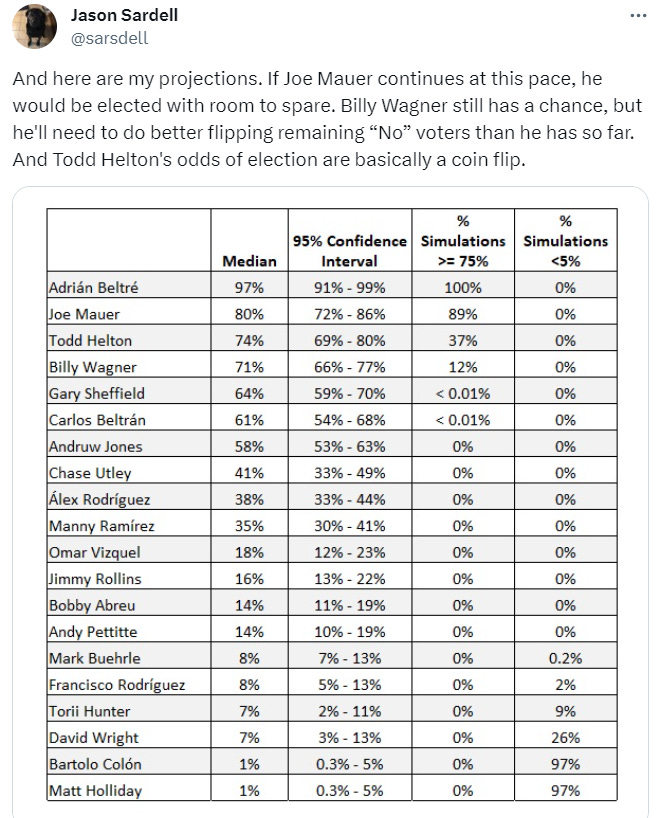The Hall Of Fame Case For Joe Mauer -- And Catchers In General
Iconic Twins catcher Joe Mauer is likely heading to Cooperstown, representing a position that traditionally has not had much Hall of Fame representation.
IBWAA members love to write about baseball. So much so, we've decided to create our own newsletter about it! Subscribe to Here's the Pitch to expand your love of baseball, discover new voices, and support independent writing. Original content six days a week, straight to your inbox and straight from the hearts of baseball fans.
Pregame Pepper
Did you know…
. . . Among all players in Minnesota Twins history, Joe Mauer’s 55.2 Baseball Reference WAR ranks third behind only Rod Carew (63.8) and Harmon Killebrew (60.5), who were both enshrined in Cooperstown in 1991 and 1984, respectively. Mauer also ranks near the top of Twins franchise leaders in many other offensive categories, including on-base percentage (sixth, .388), runs scored (sixth, 1,018), hits (fourth, 2,123), total bases (fifth, 3,040), doubles (second, 428), and RBIs (ninth, 923).
. . . Mauer’s peak years were from 2006-13, and over those eight seasons, his .327 batting average was second only to Miguel Cabrera (.328, min. 3,000 plate appearances) and his .410 on-base percentage was second only to Joey Votto (.419). Mauer is also one of 29 hitters in MLB history to win three batting titles, and Josh Gibson (Negro Leagues) is the only other catcher to do so.
Leading Off
The Hall of Fame Needs Joe Mauer — And Many More Catchers
By Daniel R. Epstein
Joe Mauer is going to become a Hall of Famer. It will probably happen this year on his first ballot. If not, he’s a shoo-in next year. As of this moment, his box has been checked by 82.5% of voters who have released their ballot publicly according to Ryan Thibodeaux’s Hall of Fame ballot tracker. Jason Sardell gives him an 89% likelihood of getting elected in 2024.
https://twitter.com/sarsdell/status/1741259210870931966
As most BBWAA voters have indicated, he’s a deserving Hall of Famer. In his 15-year career with the Minnesota Twins, he won three American League batting titles, led the league in on-base percentage twice, and was a six-time All-Star. His trophy case is filled with five Silver Sluggers, three Gold Gloves, and an MVP. His 2009 season remains one of the best in AL/NL history by a catcher.
His production took a nosedive after age 30, but the numbers he put up in his 20s are more than sufficient for baseball’s highest honor. His 55.2 bWAR is ninth all-time at the position and his 47.1 JAWS is seventh. Every player above him in both categories has already been enshrined.
Odds are that you knew all of this already. If you’re a baseball fan of a certain age, you watched Mauer play and you remember his accolades. He’s comfortably beyond a borderline case, but for those still on the fence, another 15-year MLB veteran catcher should push him across – José Molina.
Mauer and Molina were never teammates. They never crossed paths except as rivals, and it wasn’t a fair fight. Molina’s career bWAR is only 3.1 and he never won any awards or earned any All-Star appearances. But more than a decade ago, he became the poster boy for the pitch-framing revolution when he hung on with the Rays into his late 30s with no remaining baseball skills except turning balls into strikes.
Since then, we’ve learned that pitch framing isn’t just a nice bonus skill that some catchers do well. It’s an essential part of the game that provides tremendous value to the team – far more than anyone previously thought possible. Even though catchers play less than other position players, the importance of their defense makes them more indispensable than most of the other guys in the lineup.
In today’s game, we see the importance of catcher defense more clearly, even though some versions of WAR haven’t caught up. That helps us appreciate catchers in the present, but we’ve never applied this knowledge retroactively to players from before the framing enlightenment. This includes Mauer and every MLB catcher who came before him.
Even setting aside the importance of framing, catchers are underrepresented in Cooperstown. There are only 19 in the Hall right now, which is the second-lowest of any position (there are 18 third basemen). Holding catchers to the same bar as players at other positions is unfair and unrealistic, which is why several more of them deserve HOF recognition just to catch up.
Catcher has always been the most crucial defensive position on the baseball diamond. Even though we surmised this earlier, we quantified it nearly 15 years ago. It’s time to apply that knowledge to the Hall of Fame. That starts by putting Mauer over the top, but the work needs to continue by sending some of his borderline predecessors across the threshold as well.
Daniel R. Epstein serves as co-director of the Internet Baseball Writers Association of America. His writing can be found at Baseball Prospectus, Forbes SportsMoney, and Off the Bench Baseball.




Great take Daniel. With regard to pitch framing - for which Mauer was rightly praised, that catcher skill will no longer be an asset once ABS is adopted in MLB. Pitch framing is all about catchers duping umpires so it's fine that it eventually will fade away. Will ABS change how much more hitting a receiver will need to do?